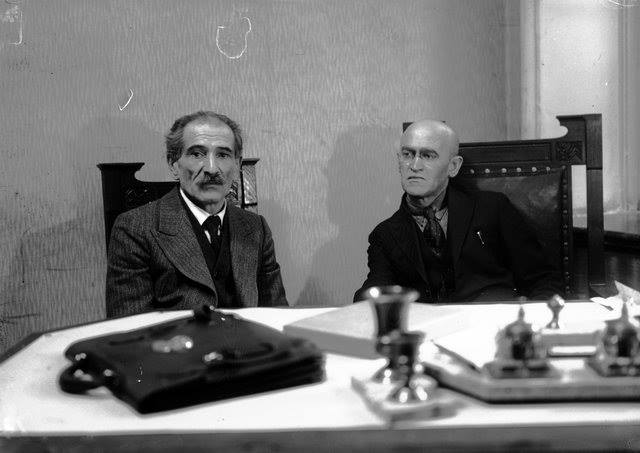|
List Of Yiddish Newspapers And Periodicals
List of Yiddish newspapers and periodicals Newspapers United States *Di Tzeitung *Der Yid *Der Blatt Periodicals United States New York * Di Tsukunft (Die Zukunft) (s. 1892) * Yugntruf * Yiddish Moment Others * Oneg Shabbos * Shpaktiv * Gigulim * Di Naye Gvardie * Dos Yidishe Kol Former newspapers Belorussia Homel * Der yidisher komunist (1919) Hrodna * Grodner Sztyme (c.1920-1939) Minsk * Oktyabr (1918-1941) Vitebsk * Der royter shtern (1920-1923) Belgium * Unzer Wort (1941-1942) * Unzer Kamf (1941-1942) Canada * Di hamiltoner yidishe shtime (1933-1943) * Der Keneder Adler (1907-1977) France Paris * Unser Stimme * Naye Prese (1934-1993) * Unzer Wort ( -1996), the worldwide last daily Yiddish-language newspaper Hungary Sziget * Yidishe Folkstsaytung (1893-1913) Lithuania Kaunas * Arbeter Tsajtung Vilnius * Folks-shtime * Der proletarisher gedank (1906-1907) * Der yidisher arbeyter * Flugblat (1915-1916) * Di royte fon (1920) Poland ... [...More Info...] [...Related Items...] OR: [Wikipedia] [Google] [Baidu] |
Di Tzeitung
''Di Tzeitung'' ( yi, די צייטונג; ''the journal'', News Report) is a Yiddish weekly newspaper published in New York City, founded and edited by Abraham Friedman, a Satmar Hasidic Jew, from Borough Park, Brooklyn, New York. It is published weekly, every Wednesday. It is sold throughout New York, especially in the Yiddish-speaking parts of Brooklyn, Williamsburg and Borough Park. The newspaper's mission is to bring news to the readers with a non-partisan look, and although the editor belongs to the Satmar community and advocates their methods, they do not interfere in its internal disputes. The newspaper's editors identify with a liberal worldview, and tend to the Democratic Party more than other Yiddish newspapers. History The first edition was published on Parshat Acharei Kedoshim 5748 (1988), under the name "Nayes Baricht". For the first three weeks, they asked customers to offer good names to the paper, and the winner would receive an eternal subscription to the pa ... [...More Info...] [...Related Items...] OR: [Wikipedia] [Google] [Baidu] |
Arbeiterstimme
''Arbeiterstimme'' (Worker's Voice) was the central organ of the General Jewish Labour Bund in Lithuania, Poland and Russia. It appeared from 1897 to 1905, as an underground publication. The Bund resumed the publication, now as a legal paper, after the February revolution.Johnpoll, Bernard K. ''The Politics of Futility; The General Jewish Workers Bund of Poland, 1917-1943''. Ithaca, N.Y.: Cornell University Press The Cornell University Press is the university press of Cornell University; currently housed in Sage House, the former residence of Henry William Sage. It was first established in 1869, making it the first university publishing enterprise in th ..., 1967. p. 55 References Anti-Zionism in Lithuania Bundism in Europe Defunct political magazines Magazines established in 1897 Magazines disestablished in 1905 Yiddish-language mass media in Lithuania Yiddish-language mass media in Poland Yiddish-language mass media in Russia {{italic title ... [...More Info...] [...Related Items...] OR: [Wikipedia] [Google] [Baidu] |
Der Shtern (Kharkov)
''Der shtern'' ( yi, דער שטערן, 'The Star') was a Yiddish language daily newspaper published from Kharkov, Ukrainian SSR between 1925 and 1941. It was an organ of the Central Committee of the Communist Party (bolsheviks) of Ukraine and the All-Ukrainian Council of Trade Unions.National Library of Russia. Yiddish Newspapers (in the Latin alphabet)' M. Levitan served as editor in chief of the newspaper. ''Der shtern'' replaced ''Komunistishe fon'' as the main Yiddish newspaper in Soviet Ukraine. The first issue of ''Der shtern'' was published in May 1925. In its initial phase ''Der shtern'' was the largest Yiddish newspaper in the Soviet Union, as well. It was printed around 12,000 copies, a larger number than that of the Moscow-based ''Der emes ''Der Emes'' (in Yiddish: , meaning 'The Truth', from he, אמת, emeth) was a Soviet newspaper in Yiddish. A continuation of the short-lived '' Di varhayt'', ''Der Emes'' began publishing in Moscow on August 8, 1918.Kotlerman, ... [...More Info...] [...Related Items...] OR: [Wikipedia] [Google] [Baidu] |
Di Tsayt (Saint Petersburg)
''Di Tsayt'' ( yi, די צײט, 'The Time') was a Yiddish language weekly newspaper published from Saint Petersburg, Russia. It was an organ of the General Jewish Labour Bund. Whilst the editorial team of ''Di Tsayt'' was based in the Austrian capital of Vienna, officially Saint Petersburg was the site of publishing for the journal.Brenner, Michael. In Search of Jewish Community: Jewish Identities in Germany and Austria, 1918-1933'. Bloomington .a. Indiana University Press, 1998. p. 117 Prominent editors included Esther Frumkin, Raphael Abramovitch, Vladimir Medem, Henryk Ehrlich, Moisei Rafes and D. Zaslavsky. The founding of ''Di Tsayt'' ended a four and half year absence of a legal Bundist press, a void created by the banning of ''Folkstsaytung'' in 1907. Saint Petersburg had been selected by the Bund Central Committee over Warsaw for the publishing of ''Di Tsayt'', as the Saint Petersburg press censors were perceived as less strict than their Warsaw colleagues. The launchin ... [...More Info...] [...Related Items...] OR: [Wikipedia] [Google] [Baidu] |
Aleksander Zederbaum
Aleksander Ossypovich Zederbaum (; August 27, 1816, Zamość – September 8, 1893, Saint Petersburg) was a Polish-Russian Jewish journalist who wrote primarily in Hebrew. He was founder and editor of ''Ha-Melitz'', and other periodicals published in Yiddish and Russian. Biography A son of poor parents, Zederbaum was apprenticed to a tailor. He succeeded in acquiring a knowledge of Hebrew literature, and of the Russian, Polish, and German languages. He married in Lublin, and in 1840 left for Odessa, then a centre of the ''Haskalah'' movement. He obtained there a commercial position, made the acquaintance of the ''Maskilim'' of the city, and in his leisure hours continued to work for his self-education. Later he opened a clothing-store, and was himself cutter in his tailoring-shop. In 1860 Zederbaum succeeded in obtaining the government's permission to publish ''Ha-Melitz'', the first Hebrew periodical issued in Russia; and three years later he began publishing the pioneer Yiddish ... [...More Info...] [...Related Items...] OR: [Wikipedia] [Google] [Baidu] |
Der Emes
''Der Emes'' (in Yiddish: , meaning 'The Truth', from he, אמת, emeth) was a Soviet newspaper in Yiddish. A continuation of the short-lived '' Di varhayt'', ''Der Emes'' began publishing in Moscow on August 8, 1918.Kotlerman, Boris (August 5, 2010).Emes, Der" ''The YIVO Encyclopedia of Jews in Eastern Europe''. Retrieved June 11, 2020. The publisher was the Central Committee of the Russian Communist Party (Bolsheviks). Moishe Litvakov was its editor-in-chief from 1921 until his arrest in the fall of 1937; after that, the newspaper was headed by an anonymous "editorial board". From January 7, 1921 to March 1930 ''Der Emes'' appeared as the organ of the Central Bureau of Yevsektsiya. In January 1939 the campaign against Yiddish culture in the USSR became widespread, and ''Der Emes'' was liquidated. Featured highlights ''Der Emes'' was a conductor of the Soviet propaganda and ideas directed at ordinary Jews in the USSR and all around the world. The most prominent line of the n ... [...More Info...] [...Related Items...] OR: [Wikipedia] [Google] [Baidu] |
Der Wecker
''Der Wecker'' () was a Yiddish-language socialist newspaper, published in Iaşi, Romania, from May to September 1896. It was published by a socialist propaganda group, which also brought out ''Lumina''. In September 1896, the publication of ''Der Wecker'' was discontinued due to financial constraints.Linden, Marcel van der, and Jürgen Rojahn. The Formation of Labour Movements, 1870-1914: An International Perspective. Contributions to the history of labour and society, v. 2'. Leiden Leiden (; in English and archaic Dutch also Leyden) is a city and municipality in the province of South Holland, Netherlands. The municipality of Leiden has a population of 119,713, but the city forms one densely connected agglomeration wit ...: E.J. Brill, 1990. p. 369 See also * History of the Jews in Iași References 1896 establishments in Romania 1896 disestablishments in Romania Defunct newspapers published in Romania Jews and Judaism in Iași Mass media in Iași Newspapers p ... [...More Info...] [...Related Items...] OR: [Wikipedia] [Google] [Baidu] |
Wloclawker Weker
''Wloclawker Weker'' was a Yiddish-language weekly newspaper in interbellum Poland, published from Włocławek. ''Wloclawker Weker'' was an organ of the General Jewish Labour Bund in Poland.Labour and Socialist International. ''The Socialist Press - The press of the parties affiliated to the Labour and Socialist International''. Series 4 - No. 2. Brussels Brussels (french: Bruxelles or ; nl, Brussel ), officially the Brussels-Capital Region (All text and all but one graphic show the English name as Brussels-Capital Region.) (french: link=no, Région de Bruxelles-Capitale; nl, link=no, Bruss ..., August 1939. p. 56 References {{Poland-newspaper-stub General Jewish Labour Bund in Poland Yiddish socialist newspapers Defunct newspapers published in Poland Yiddish-language mass media in Poland Mass media in Włocławek Weekly newspapers published in Poland ... [...More Info...] [...Related Items...] OR: [Wikipedia] [Google] [Baidu] |
Folkstsaytung
The ''Folkstsaytung'' ( yi, פֿאָלקסצייטונג, 'People's Newspaper') was a Yiddish language daily newspaper which served as the official organ of the General Jewish Labour Bund in Poland. ''Folkstsaytung'' was published in Warsaw, Second Polish Republic. It began publication in 1921 and officially lasted until the Nazi invasion of Poland in 1939. Thereafter it continued on as an illegal underground newspaper until 1943. Its first editors were Victor Alter and Henrik Erlich. In 1927 it was renamed ''Naye Folkstsaytung'' ("New People's Paper").Yivo Institute for Jewish Research, "Here and Now: The Vision of the Jewish Labor Bund in Interwar Poland", When Ehrlich and Alter became preoccupied with their leadership responsibilities in the Bund, Leyvik Hodes took over editorial responsibility. It began to be published again after World War II but in 1948 it was taken over by Communist authorities and disbanded.Hershel Edelheit, "History of the Holocaust: a handbook and dic ... [...More Info...] [...Related Items...] OR: [Wikipedia] [Google] [Baidu] |
Haynt
''Haynt'' (הײַנט - "Today"; Yidishes tageblat 1906-08) was a Yiddish daily newspaper, published in Warsaw from 1906 until 1939. Newspaper ''Yidishes tageblat'' (יידישעס טאגעבלאט) was founded in 1906 by Zionist Samuel Jackan, a former contributor to the Hebrew language paper Ha-Tsefirah. In 1908 ''Yidishes tageblat'' changed its name to ''Haynt'' and quickly established itself as the premier Yiddish newspaper in the Congress Poland. The practice of reprinting Yiddish fiction in serialized form helped ''Haynt'' set new circulation records for Yiddish journalism. By 1913 the newspaper reached a circulation of more than 150,000 copies. From 1908 till 1932 ''Haynt'' was a private company. In 1932 a cooperative called ''Alt-Nay'' was formed by the staff, who administered the newspaper ever since. Contributors * Esriel Carlebach (עזריאל קארלעבאך), also under pseudonym ''Levi Gotthelf'' (לוי גאָטהעלף). *Boris Smolar * Moshe Sneh *Sholem A ... [...More Info...] [...Related Items...] OR: [Wikipedia] [Google] [Baidu] |
Folks-Sztyme
''Folks-Sztyme'' ( yi, פֿאָלקס שטימע), or ''People's Voice'' in English, was a bilingual magazine published in Polish and Yiddish in Communist Poland between 1946 and 1991. An homonymous newspaper existed before World War II. According to Henri Minczeles, the paper began to be circulated in 1946, from Łódź, but it moved to Warsaw Warsaw ( pl, Warszawa, ), officially the Capital City of Warsaw,, abbreviation: ''m.st. Warszawa'' is the capital and largest city of Poland. The metropolis stands on the River Vistula in east-central Poland, and its population is officia ... after a few years. In 1953, the American Jewish Yearbook noted that "The only newspaper was the Communist Folks-Sztyme. It appeared four days a week and had an illustrated weekly supplement. ''Yiddishe Szriften'', a monthly devoted to literature and art, continued to appear under the sponsorship of the Social and Cultural Union." From 1956 onwards, it was published by the official Jewish ass ... [...More Info...] [...Related Items...] OR: [Wikipedia] [Google] [Baidu] |

